Charles E W Bean, Diaries, AWM38 3DRL 606/251/1 - 1915 - 1936 - Part 12

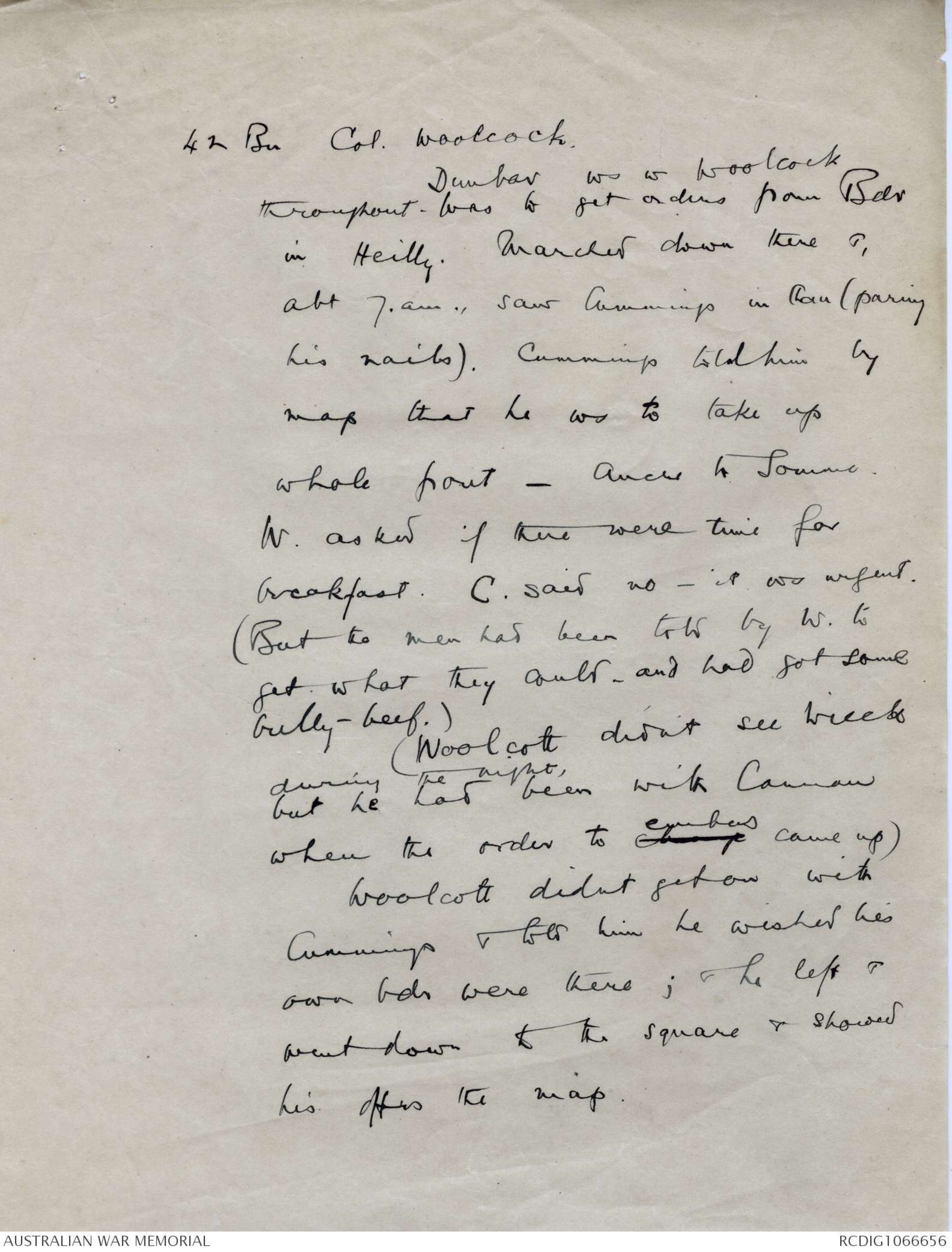
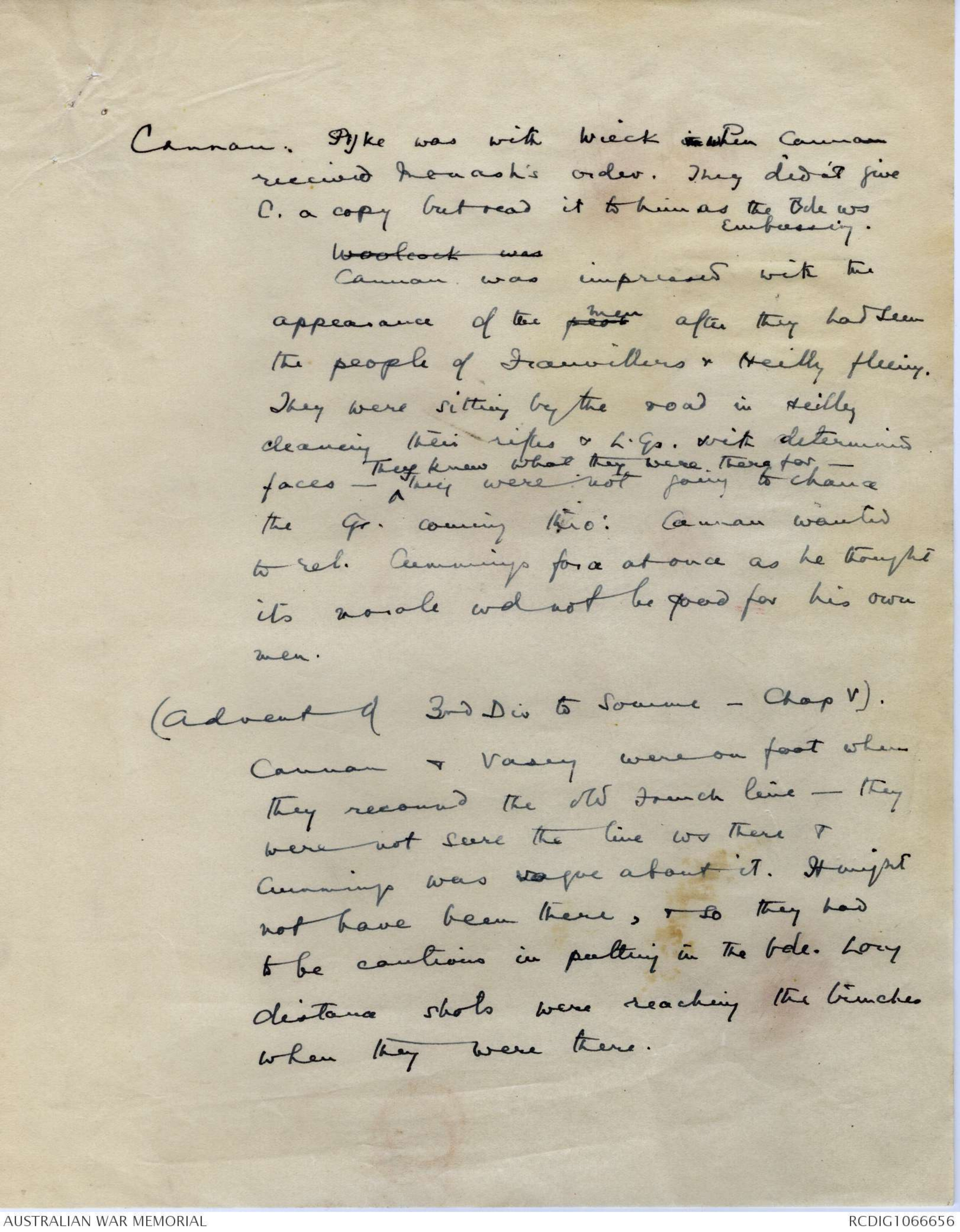
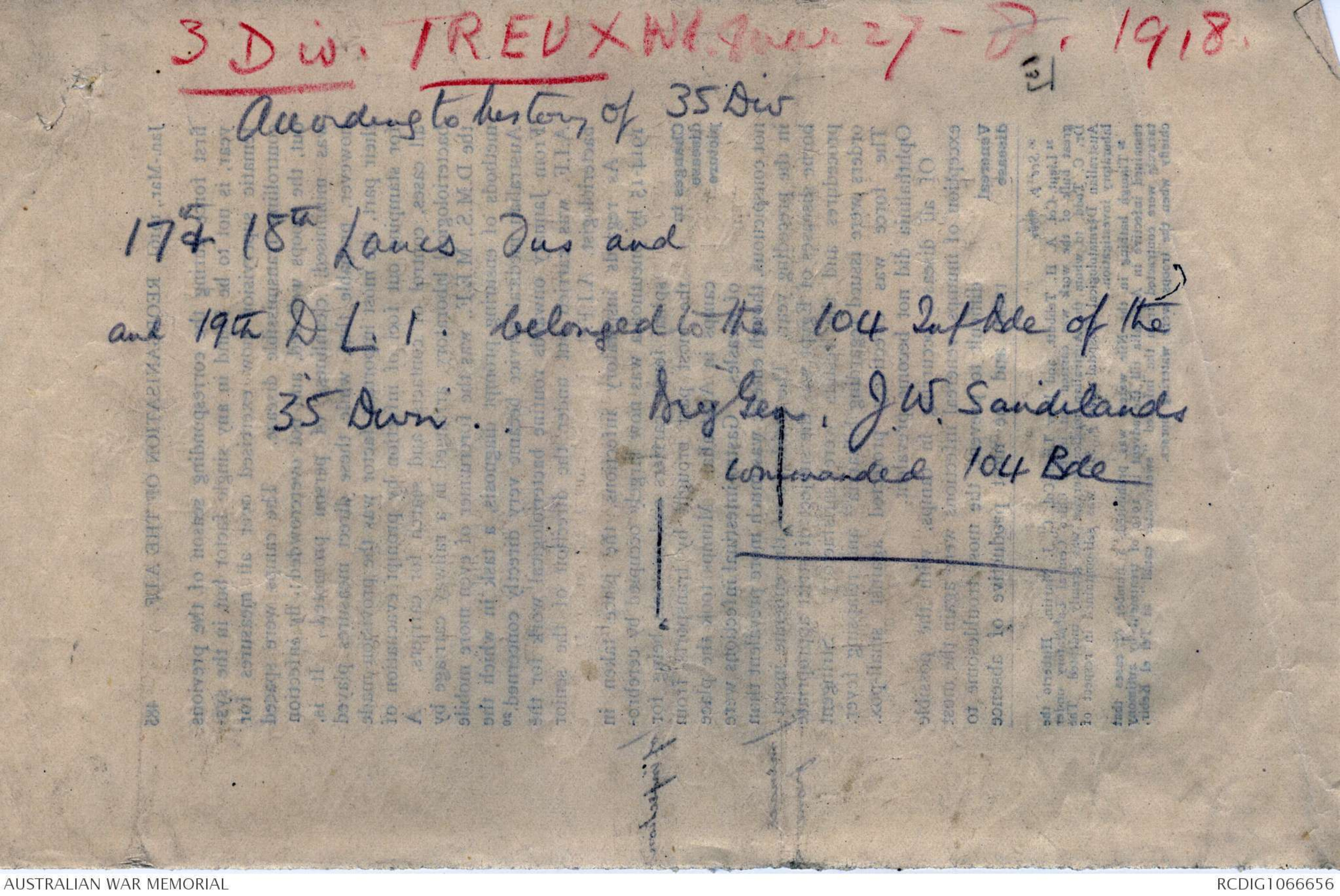
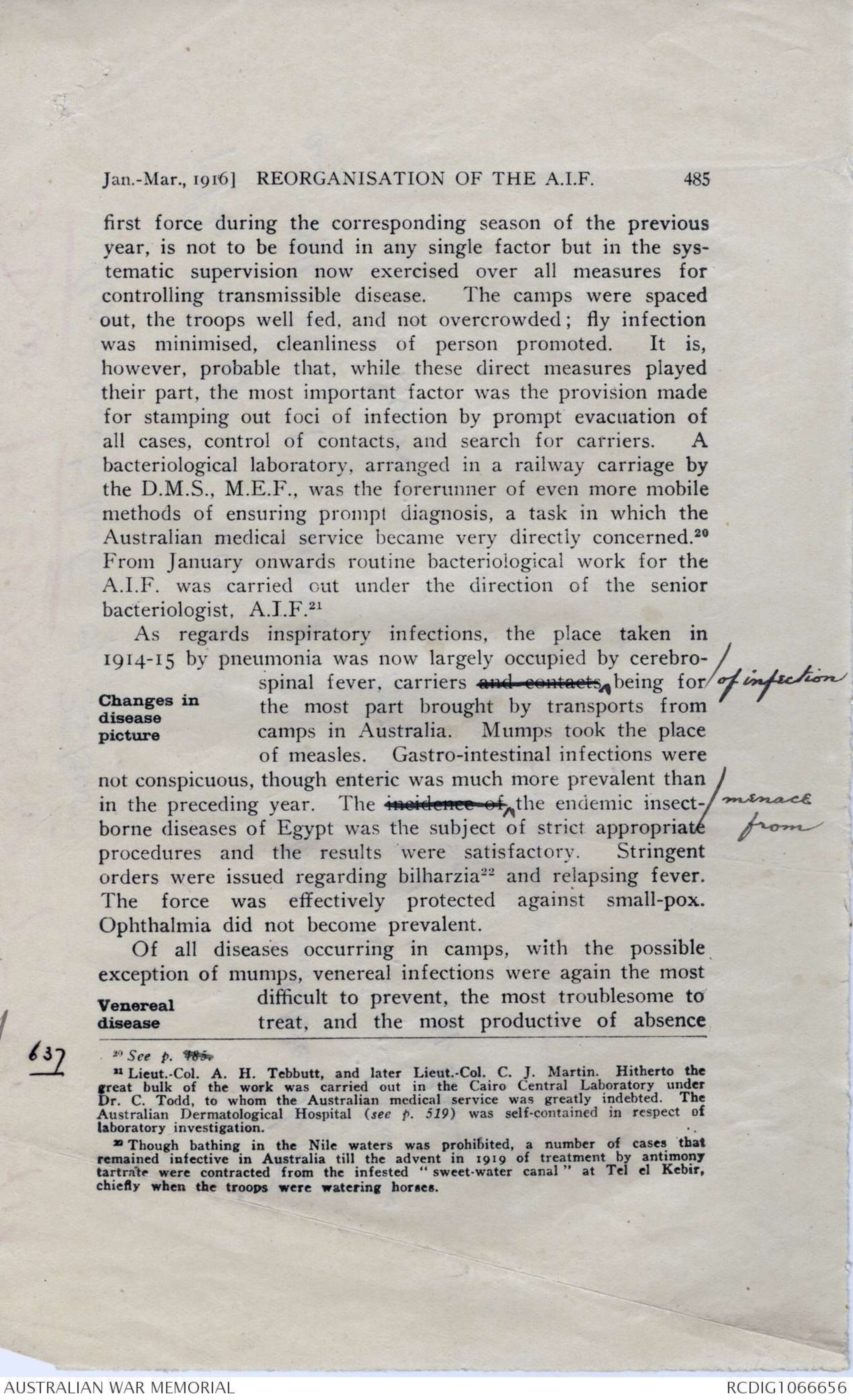
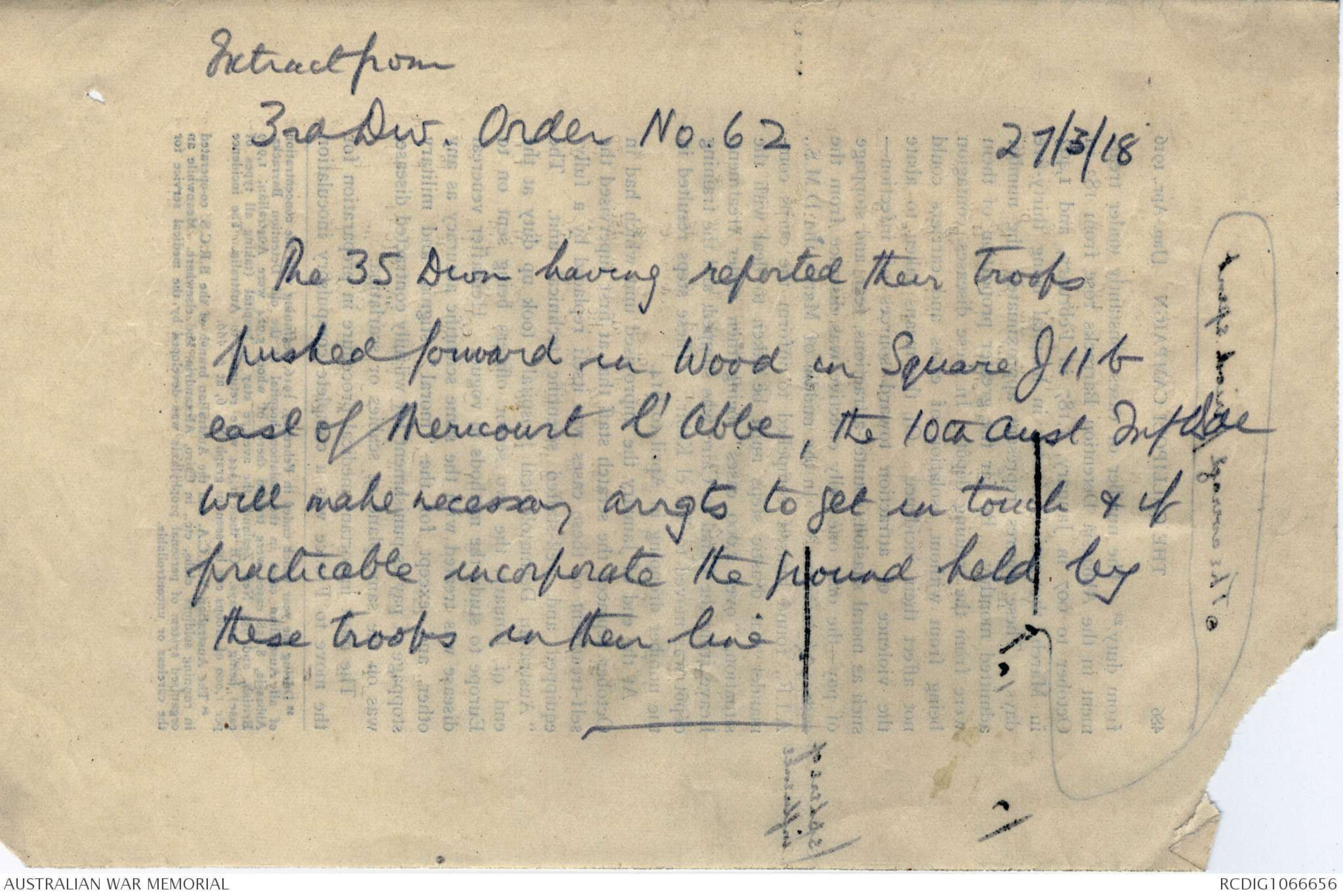
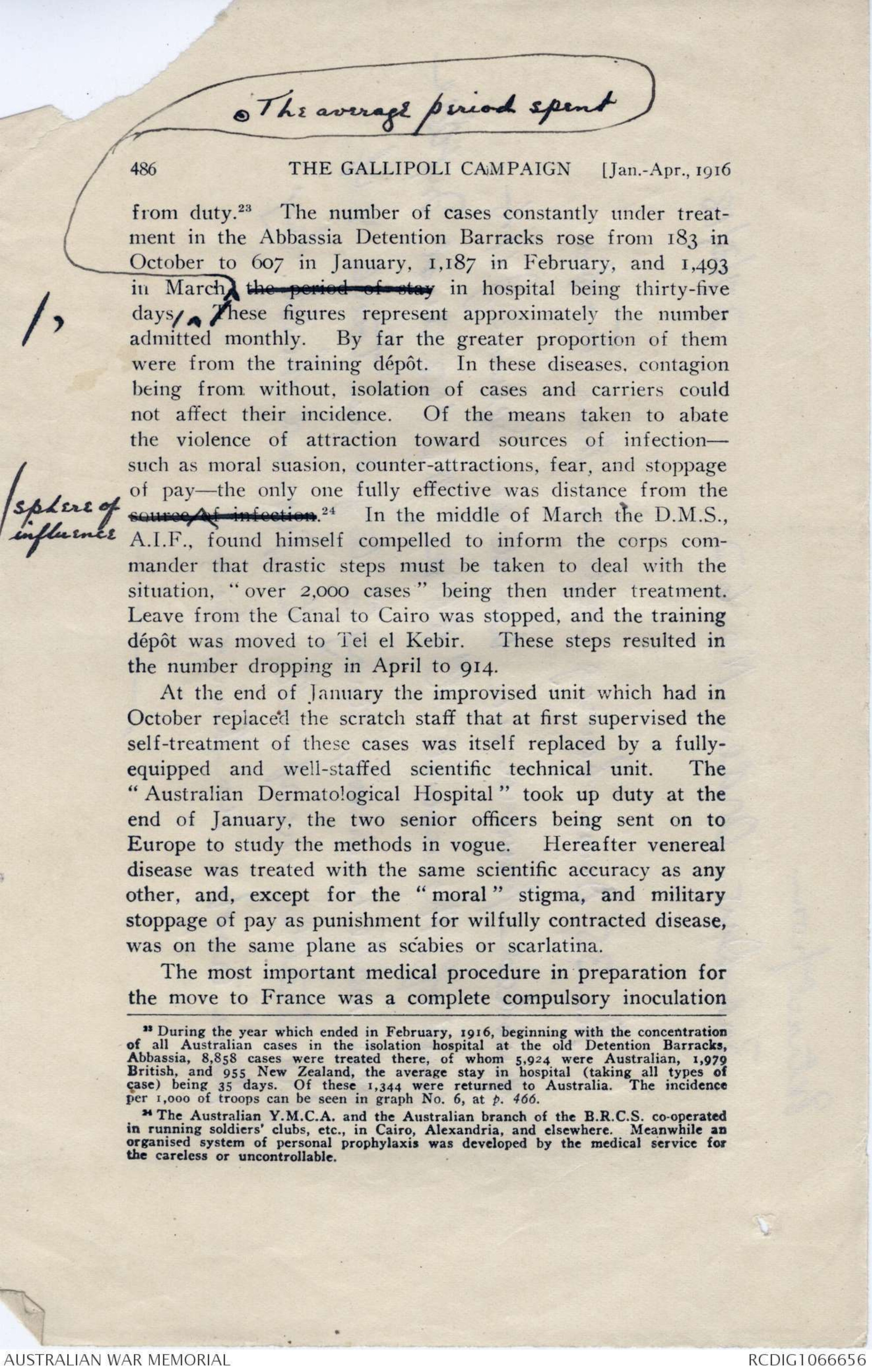
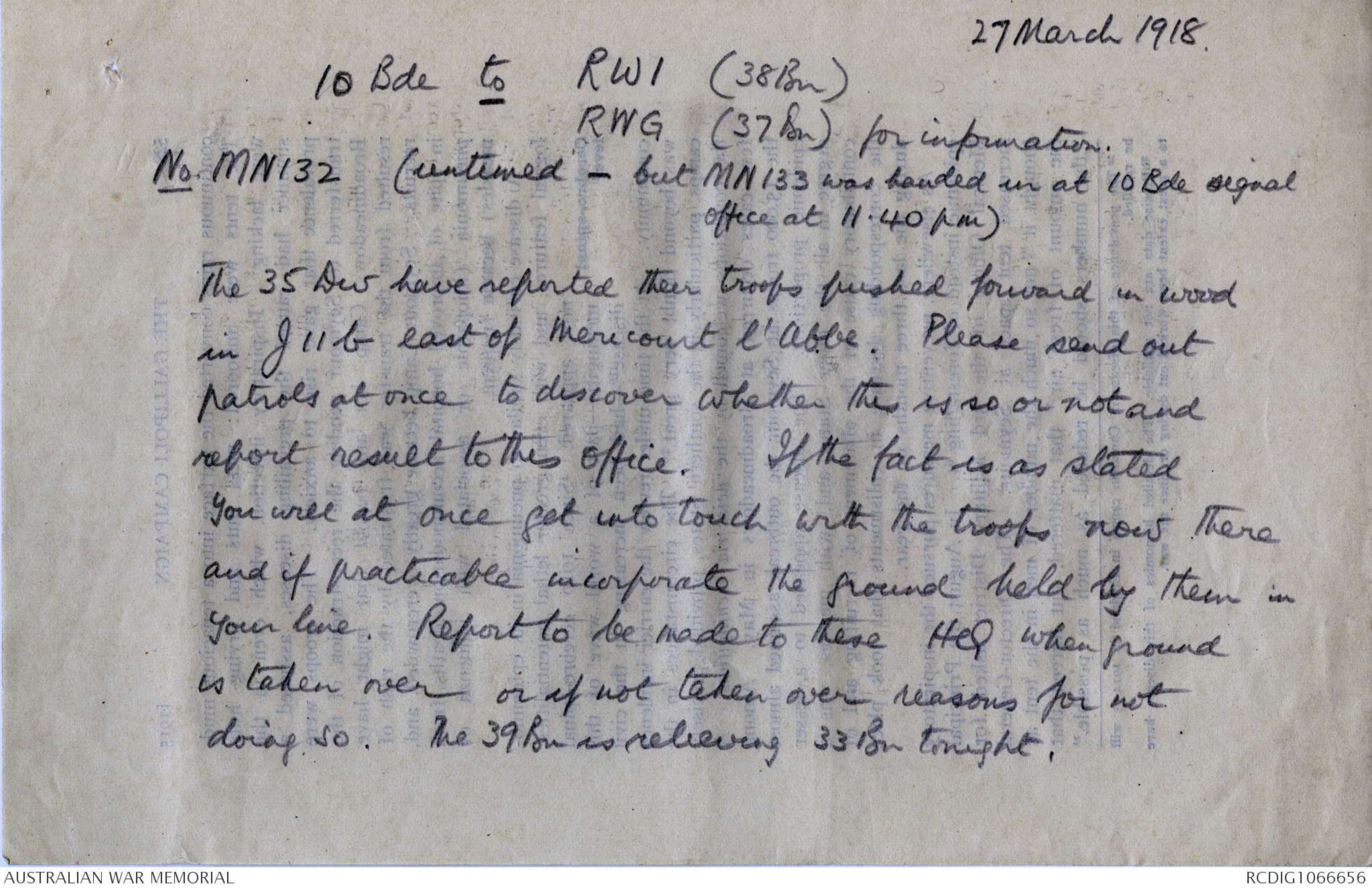
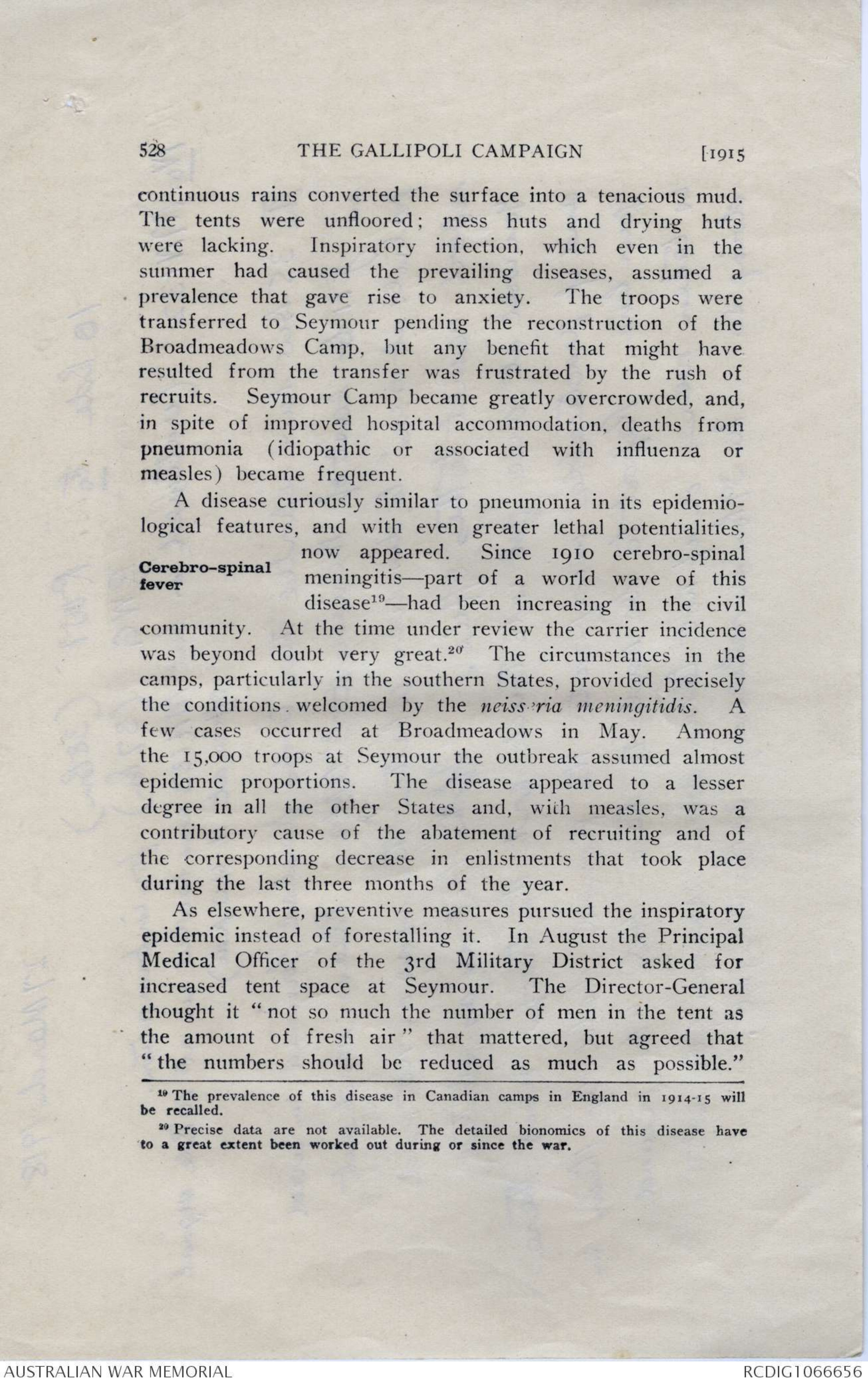
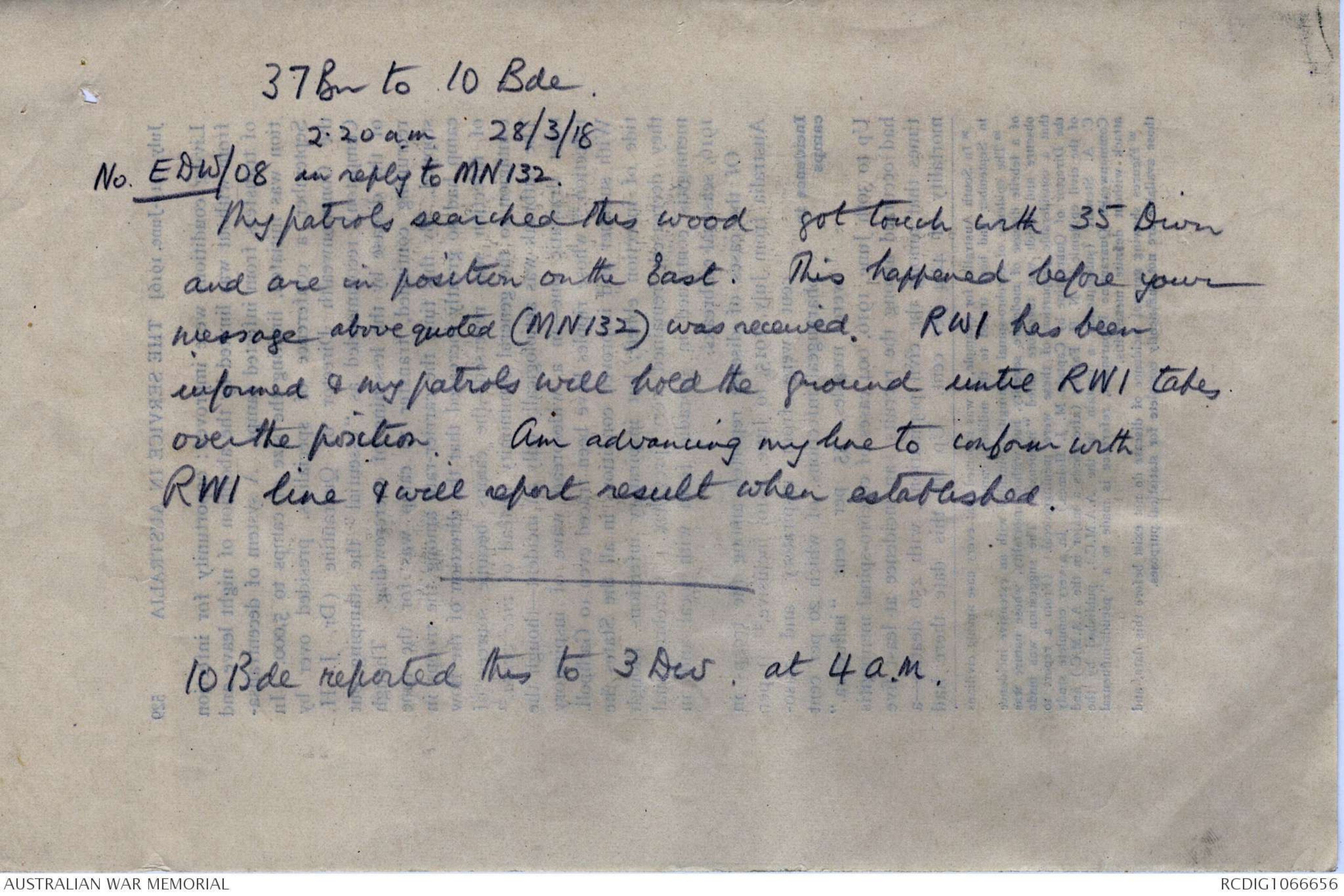
HN
Swan Barracks, Perth.
30.10.33
My dear Bean,
I have just received the typed Instructions dated 27th
March 1918, and have perused them with much interest. I will do
my best to clear up this matter.
Firstly, the original of the message book Instructions
was handed to a battalion commander near the head of the column.
Up to now I have always ^thought that officer to be Woolcock. It was dark
and confusing and perhaps seeing Woolcock in the vicinity, or
soon after, I erred in thinking it was he. I cannot understand not
mentioning this in the War Diary.
Secondly, I do not think I mad a third copy. It was not
usual to do so. I think possibly I read it to Cannan by the light
of a head-lamp, and kept the duplicate in my book.
The typed Instructions are the same Instructions in a
slightly embellished form. At Montigny we did not know the order
in which units would arrive nor even if all would be in the same
column: hence they are referred to in order of arrival. In my
notes (now in War Museum) no reference is made to frontages &c
because these would be marked on my map (I had my old Somme maps
with me). Similarly, there was no reference to Woolcock and Cummings
because we did not at the time know where Cummings was or
whether Woolcock's battalion would be available. Woolcock could
not be given any order to report before he arrived at Franvillers.
We met the bus column and Monash stood chatting for some time with
senior officers: at the same time I had to attend to other duties
and if the orders were verbal they were not confirmed in writing
unless the A.D.C. (Capt. P.Simonson) did so.
If we could find out which unit led the bus column we
would know automatically to whom I handed the Instructions. I
suggest also asking Woolcock where and from whom he received his
orders to report to Cummings. If I wrote them I have no recollection
of it.
As regards the typed Instructions, I certainly wrote a
draft just after daylight at Couturelle. This draft may have been
for the move of the remainder of the Division or it may have been
the reproduced Instructions. I may have written both. While I
wrote the draft Instructions on 27/3/18 it may not have been
typed until next day and this would account for the date of typing
entered above the Instructions. The reason for the reproduction
is that other people would require to know what was happening &
I was about to return to Montigny with my copy. Further, the original
was written under adverse conditions and the copy would not be very
brilliant. In drafting the reproduction I suppose I added a few
frills etc, but on no account would I alter or vary the orders
given. On this draft would be based the order for the move of the
remainder of the Division.
I believe if I were close enough to Sydney to be able to
go and read the War Diary the whole story would unfold in my mind. As
I was a somewhat prolific writer in the Diary I feel keenly that I
did not cover this part of the ground thoroughly. I was easily the
hardest worked man in the Division at the time and any omission is
excusable, I think. What I cannot understand is where my message
book copy of the Instructions has gone" I would give a lot to see
it. If I remember rightly its first sentence dealt with the fact
that no 1/40000 maps were available - this comes lower down in the
reproduction.
I am sorry I cannot be more exact in chasing the Woolcock
"hare" but as I have ^no war papers of any kind I am forced to rely
entirely upon memory. The flesh is very willing but 15 years is a
long time. I would like to help in every possible way.
Thanks for good wishes which are fully reciprocated,
Yours sincerely,
Leo J Wieck
42 Bn Col. Woolcock.
Dunbar ws w Woolcock
through - was to get orders from Bdr
in Heilly. Marched down there &,
abt 7.am., saw Cummings in [bar?] (paring
his nails). Cummings told him by
map that he ws to take up
whole front - March to Somme.
W. asked if there were time for
breakfast. C. said no - it ws urgent.
(But the men had been told by W. to
get what they could - and had got some
bully-beef.)
(Woolcott didnt see Wieck
during the night,
but he had been with Cannan
when the order to change enbus came up)
Woolcott didnt get on with
Cummings & told him he wished his
own bdr were there; & he left &
went down to the square & showed
his offrs the map.
Cannan. Pyke was with Wieck in when Cannan
received Monash's order. They didn't give
C. a copy but read it to him as the Bde was
enbussing.
Woolcock was
Cannan was impressed with the
appearance of the peol men after they had seen
the people of Framvillers & Heilly fleeing.
They were sitting by the road in Heilly
cleaning their rifles & L.Gs. with determined
faces - ^They knew what they were there for-They were not going to chance
the Gr. coming thro: Cannan wanted
to rel. Cummings for a at once as he thought
its morale wd not be good for his own men.
(Advent of 3rd Div to Somme - Chap V).
Cannan & Vasey were on foot when
they reconnd the W French line - they
were not sure the line ws there &
Cummings was vague about it. It might
not have been there, & so they had
to be cautious in putting in the bde. Long
distance shots were reaching the trenches
when they were there.
3 Div. TREVXWI. Mar 27-8. 1918
According to history of 35 Div
17th & 18th Lancs Div and
and 19th D.L.I. belonged to the 104 Inf Bde of the
35 Divn. Brig Gen. J.W. Sandilands
commanded 104 Bde.
Jan.-Mar., 1916] REORGANISATION OF THE A.I.F. 485
first force during the corresponding season of the previous
year, is not to be found in any single factor but in the systematic
supervision now exercised over all measures for
controlling transmissible disease. The camps were spaced
out, the troops well fed, and not overcrowded; fly infection
was minimised, cleanliness of person promoted. It is,
however, probable that, while these direct measures played
their part, the most important factor was the provision made
for stamping out foci of infection by prompt evacuation of
all cases, control of contacts, and search for carriers. A
bacteriological laboratory, arranged in a railway carriage by
the D.M.S., M.E.F., was the forerunner of even more mobile
methods of ensuring prompt diagnosis, a task in which the
Australian medical service became very directly concerned. 20
From January onwards routine bacteriological work for the
A.I.F. was carried out under the direction of the senior
bacteriologist, A.I.F. 21
As regards inspiratory infections, the place taken in
1914-15 by pneumonia was now largely occupied by cerebrospinal
[Changes in disease picture]
fever, carriers and contacts^ being for/of infection
the most part brought by transports from
camps in Australia. Mumps took the place
of measles. Gastro-intestinal infections were
not conspicuous, though enteric was much more prevalent than
in the preceding year. The incidence of ^the endemic insect-/menace from borne diseases of Egypt was the subject of strict appropriate
procedures and the results were satisfactory. Stringent
orders were issued regarding bilharzia22 and relapsing fever.
The force was effectively protected against small-pox.
Ophthalmia did not become prevalent.
Of all diseases occurring in camps, with the possible
exception of mumps, venereal infections were again the most
[Venereal disease] difficult to prevent, the most troublesome to
treat, and the most productive of absence
-----------------------------------------
637 20 "See p. 485.
21 Lieut.-.Col.A.H. Tebbutt, and later Lieut.-Col. C.J.Martin. Hitherto the
great bulk of the work was carried out in the Cairo Central Laboratory
under Dr.C.Todd, to whom the Australian medical service was greatly indebted. The
Australian Dermatological Hospital (see p.519) was self-contained in respect of
laboratory investigation.
22 Though bathing in the Nile waters was prohibited, a number of cases that
remained infective in Australia till the advent in 1919 of treatment by antimony
tartrate were contracted from the infested "sweet-water canal" at Tel el Kebir,
chiefly when the troops were watering horses.
Extract from
3rd Div. Order No. 62 27/3/18
The 35 Divn having reported their troops
pushed forward in Wood in Square J 11G
east of Mericourt l'abbe, the 10th Aust Inf bde
will make necessary arrgts to get in touch & if
practicable incorporate the ground held by
these troops in their line.
486 THE GALLIPOLI CAMPAIGN [Jan.-Apr., 1916
from duty 23. The number of cases constantly under treatment
in the Abbassia Detention Barracks rose from183 in
October to 607 in January, 1,187 in February, and 1,493
in March. ^The average period spent the period of stay in hospital being thirty-five
days, these figures represent approximately the number
admitted monthly. By far the greater proportion of them
were from the training depot. In these diseases, contagion
being from without, isolation of cases and carriers could
not affect their incidence. Of the means taken to abate
the violence of attraction toward sources of infection -
such as moral suasion, counter-attractions, fear, and stoppage
of pay - the only one fully effective was distance from the
sphere of influence source of infection. 24 In the middle of March the D.M.S.,
A.I.F., found himself compelled to inform the corps commander
that drastic steps must be taken to deal with the
situation, "over 2,000 cases" being then under treatment.
Leave from the Canal to Cairo was stopped, and the training
depot was moved to Tel el Kebir. These steps resulted in
the number dropping in April to 914.
At the end of January the improvised unit which had in
October replaced the scratch staff that at first supervised the
self-treatment of these cases was itself replaced by a fully-
equipped and well-staffed scientific technical unit. The
"Australian Dermatological Hospital" took up duty at the
end of January, the two senior officers being sent on to
Europe to study the methods in vogue. Hereafter venereal
disease was treated with the same scientific accuracy as any
other, and, except for the "moral" stigma, and military
stoppage of pay as punishment for wilfully contracted disease,
was on the same plane as scabies or scarlatina.
The most important medical procedure in preparation for
the move to France was a complete compulsory inoculation
-----------------------------------------------------------
23 During the year which ended in February, 1916, beginning with the concentration
of all Australian cases in the isolation hospital at the old Detention Barracks,
Abbassia, 8,858 cases were treated there, of whom 5,924 were Australian, 1,979
British, and 955 New Zealand, the average stay in hospital (taking all types of
case) being 35 days. Of these 1,344 were returned to Australia. The incidence
per 1,000 of troops can be seen in graph No. 5, at p. 466.
24 The Australian Y.M.C.A. and the Australian branch of the B.R.C.S. co-operated in running soldiers' clubs, etc., in Cairo, Alexandria, and elsewhere. Meanwhile
an organised system of personal prophylaxis was developed by the medical service for the careless or uncontrollable.
27 March 1918.
10 Bde to RWI (38 Bn)
RWG (37 Bn) for information.
No. MN132 (untimed - but MN133 was handed in at 10Bde signal
office at 11.40pm)
The 35 Div have reported their troops pushed forward in wood
in J 11 G east of Mericourt l'Abbe. Please send out
patrols at one to discover whether this is so or not and
report result to this office. If the fact is as stated
You will at once get into touch with the troops now there
and if practicable incorporate the ground held by them in
your line. Report to be made to these HQ when ground
is taken over or if not taken over reasons for not
doing so. The 39 Bn is relieving 33 Bn tonight.
528 THE GALLIPOLI CAMPAIGN [1915
continuous rains converted the surface into a tenacious mud.
The tents were unfloored; mess huts and drying huts
were lacking. Inspiratory infection, which even in the
summer had caused the prevailing diseases, assumed a
prevalence that gave rise to anxiety. The troops were
transferred to Seymour pending the reconstruction of the
Broadmeadows Camp, but any benefit that might have
resulted from the transfer was frustrated by the rush of
recruits. Seymour Camp became greatly overcrowded, and,
in spite of improved hospital accommodation, deaths from
pneumonia (idiopathic or associated with influenza or
measles) became frequent.
A disease curiously similar to pneumonia in its epidemiological
features, and with even greater lethal potentialities,
now appeared. Since 1910 cerebro-spinal
[Cerebro-spinal fever]
meningitis-part of a world wave of this
disease19 - had been increasing in the civil
community. At the time under review the carrier incidence
was beyond doubt very great20. The circumstances in the
camps, particularly in the southern States, provided precisely
the conditions welcomed by the neisseria meningitidis. A
few cases occurred at Broadmeadows in May. Among
the 15,000 troops at Seymour the outbreak assumed almost
epidemic proportions. The disease appeared to a lesser
degree in all the other States and, with measles, was a
contributory cause of the abatement of recruiting and of
the corresponding decrease in enlistments that took place
during the last three months of the year.
As elsewhere, preventive measures pursued the inspiratory
epidemic instead of forestalling it. In August the Principal
Medical Officer of the 3rd Military District asked for
increased tent space at Seymour. The Director-General
thought it "not so much the number of men in the tent as
the amount of fresh air" that mattered, but agreed that
"the numbers should be reduced as much as possible."
---------------------------------------------------------------
19 The prevalence of this disease in Canadian camps in England in 1914-15
will be recalled.
20 Precise data are not available. The detailed bionomics of this disease have
to a great extent been worked out during or since the war.
37 Bn to 10 Bde.
2.20 a.m. 28/3/18
No. EDW/08 in reply to MN 132.
My patrols searched the wood got touch with 35 Divn
and are in position on the East. This happened before your
message above quoted (MN132) was received. RWI has been
informed & my patrols will hold the ground until RWI takes
over the position. Am advancing my line to conform with
RWI line & will report result when established.
---------------------------------------
10 Bde reported this to 3 Div. at 4 a.m.
 Sam scott
Sam scottThis transcription item is now locked to you for editing. To release the lock either Save your changes or Cancel.
This lock will be automatically released after 60 minutes of inactivity.